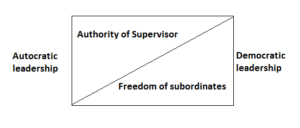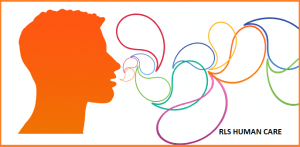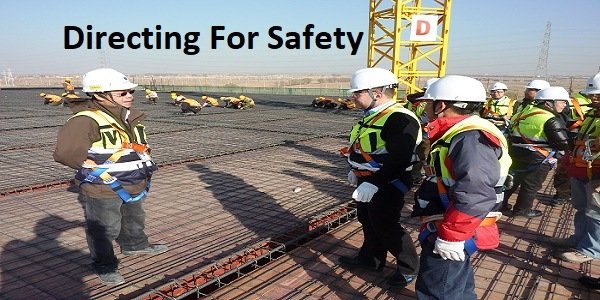Contents
Meaning of Directing For Safety
Once the objectives are decided and planning is made how to achieve them, organization structure is designed by staff, appointing qualified and experienced persons and the organization can be said ready for action.
But this action cannot begin until orders anti instructions are issued i.e. the employees are ‘directed’ to carry the orders. This process of inspiring and guiding people what to do and how to do the best of their ability is known as ‘directing’.
Thus after planning, organizing and staffing, directing is the fourth managerial function it is that part of the management process which guides, inspires, instructs arid harnesses people to work effectively and efficiently to achieve the goals.
CLICK HERE FOR 👉 Organizing for Safety
Definitions of Directing For Safety:
- Urwick and Brech Directing is the guidance; the inspiration, the leadership of those men and women that constitute the real core of the responsibility of management.
- J. L. Massie Directing concerns the total manner in which a manager influences the actions of subordinates. It is the final action of a manager in getting others to act after all preparations have been completed.
Process of Directing For Safety:
The process of directing consists of the following steps
- Issue orders and instructions. They should be clear, complete and within capabilities ‘the followers.
- Provide and continue guidance and supervision to ensure that the assigned tasks are carried out effectively and efficiently.
- Maintain discipline and reward for good work.
- Inspire and motivate to work hard to achieve the goals.
Thus motivation, supervision, Leadership communication are the main elements of directing.
CLICK HERE FOR 👉 Planning for Safety
Nature of Direction: The main characteristics of directing are
- Pervasive function – every manager has to guide and inspire his subordinates.
- Continuing or ongoing function.
- Linking fomentation between preparatory functions (planning, organizing and staffing) and controlling.
- Creative function – it converts plans into performance. It is the management in actions. it brings life for organization.
- Human factor – Involves human behavior for which motivation is useful.
- Chain of command – It flows from top to bottom. Each superior directs his subordinates.
Role (benefits) of Direction:
- Initiates action
- Ensures co-ordination
- Improves efficiency and effectiveness
- Facilitates change and
- Assists stability and growth
Principles of Direction: They are
- Harmony of objectives – Management should take care of personal goals of employees with the organizational goals.
- Unity of command – One subordinate should get orders/instructions from one superior only.
- Direct supervision – There should be personal or direct supervision.
- Good communication – Helps to improve understanding and speed of work.
- Maximum contribution Managers should try to get maximum possible contribution from each subordinate.
- A appropriate techniques – The techniques should be suitable to superior, subordinates and situation to get efficiency.
- Strategic use of informal organization – Some informal group should be contacted to decide direction.
- Comprehension – Orders should be clear, complete and understandable.
- Good Leadership – Managers should guide and counsel subordinates to win their Confidence and trust.
- Follow-up – Managers should follow-up their orders and modify if necessary.
CLICK HERE FOR 👉 SAFETY MANAGEMENT ITS RESPONSIBILITIES
Techniques of direction:
Generally four techniques are available for directing. They are delegation of authority, supervision, orders and instructions.
By delegation of authority a superior entrusts his subordinates with certain rights or powers: He assigns a part of his work and authorizes him to do work.
Supervision means expert overseeing of subordinates at work to ensure compliance of plans and procedures. At operating level it is most useful and effective.
The terms order, instruction, directive and command are used interchangeably in management literature. They mean to initiate, modify or stop an activity. It is a primary tool by which activities are started, altered, guided and terminated.
CLICK HERE FOR 👉 Modern Management Thoughts (Recent Trends)
Above definitions, principles and techniques of direction are equally applicable to the area of safety and safety managers should know and follow them while guiding: inspiring, motivating and instructing workers to detect and remove unsafe conditions and actions and to maintain safe environment in their day to day activities.
Leadership
Meaning:
It is an indivisible part of the process of directing as explained in earlier part. It is a tool or means which makes direction effective.
Dr. Terry says that managers have to manage business which means that they have to provide leadership. They have to instil in them desire to achieve the goals, a desire to improve their performance and a sense of cooperation.
If the managers fail to provide such leadership the employees will search the leadership outside which may lead to conflict or distraction.
CLICK HERE FOR 👉 MANAGEMENT PRINCIPLES
Definitions:
- Koontz and O’ Donnell – Leadership is influencing people to follow in the achievement of common goal.
- Terry – It is the ability of influencing people to strive willingly for natural objectives.
- R. T. Livingston – it is the ability to awaken in others the desire to follow a cannon objective.
Role and Functions of a Leader
- He should be clear about common objectives (goals) and should communicate them clearly.
- He has to influence, guide, instruct, inspire and supervise his subordinates to work efficiently and effectively.
- He has to generate (awaken) desire in followers to achieve the common goal.
- He works along with his followers shows them how to work and gets their cooperation in return.
- He should convince the followers that in protection of organizational (group) goals, lies the protection of their personal goals.
- He has to provide continuous guidance till the achievement of goals.
- Depending on situation he should alter, modify or stop order and should not be rigid in his decision.
- He has to set an example by his own behavior. Urwick has rightly said that ‘It is not what a leader says, still less what he writes, that influences subordinates. It is what he is. And they judge what he is by what he does and how he behaves.
Attributes of a Leader:
Certain qualities are necessary for leadership but they must be applied at the correct place and time. Dr. Terry mentioned following qualities of a leader.
- Energy – Physical and mental fitness to work by self and to guide for a longer time.
- Teaching ability – He should be a good teacher.
- Emotional stability – should be free from bias and anger and not emotional.
- Empathy – It means the ability to understand other’s view point. He should have respect for others and their beliefs.
- Objectivity – He should be objective to others and should find out reasons for requests or refusal by his subordinates.
- Enthusiasm – is required it; leader. He should be self motivated and capable of motivating others.
- Knowledge of HR – Leader has to deal with human beings and therefore he should posses’ knowledge of human resources.
- Communicative skill – He should be effective in his speech, talk and forceful impression.
- Social skill – He should mix with his followers freely and socially. He should appreciate’ opinion and work with close co-operation.
- Technical competence – Doubtlessly he must be technically more competent so that he successfully teach technical aspects.
CLICK HERE FOR 👉 HISTORY OF SAFETY
Leadership Styles (Techniques): They are three types-
- Autocratic or Dictatorial leadership.
- Democratic or Consultative or Participative. Leadership.
- Free Rein or Laissez Faire leadership.
In autocratic leadership subordinates have les freedom which increases in democratic leadership Superior enjoys more authority in autocratic leadership and less authority in democratic leadership.

Autocratic leadership is useful when subordinates are illiterate, unskilled, untrained and secrecy in decision making is required. It can be applied when there is a clear chain of command or clear-cut division of authority. Its features are retention of power, relying on orders only and close supervision.
In Safety Management, autocratic leadership style is not suitable as safety is not to be imposed like military discipline, and involvement of employees (educated or uneducated) at all levels is required.
The concept of employee’s participation, safety committee, safety education and training and “Safety is everybody’s duty” can be well implemented by democratic or consultative leadership style.
CLICK HERE FOR 👉 HIRA
In designing safety guard or its improvement by ergonomic factor, developing safe work method: meeting safety targets by group cooperation, celebrating safety programmed, creating and maintaining safety awareness and emergency preparedness, suggestions and involvement in decision-making of employees are most useful.
Therefore, democratic leadership style at workers and middle level and free-rein leadership style at higher (executive) level are desirable for safety management.
Communication
This is another element of the management process of ‘directing’ and also useful for effective leadership, motivation, supervision and getting the work done.

Motivation cannot succeed without communication. It is a process involving the transmission and reception of messaging eliciting meaning in the mind of the receiver and resulting in appropriate action which is desired.
Through one way communication such as speech, posters, instruction, radio, TV has their uses, two way communications is the only effective way to transfer an. idea from one mind to another.
Two way communications allows for clarification and amplification. Safety communication should be more clear, loud and effective.
By good efforts create responses, desires, insight and action as soon as possible. Audio visual display, transparency and modern teaching aid should be used for effective communication.
Definitions and Meaning:
- Haimann – Communication means the process of passing information and understanding from one person to another. It is the process of imparting ideas and making oneself understand by others. It is fundamental and vital to all managerial functions.
- Newman and Summer – It is an exchange of facts, ideas, opinions or emotions by two or more persons.
- Koontz and O’Donnell – It is an intercourse, by words, letters, symbols or messages, and is a way that one organization member shares meaning and understanding with another.
Chester Bernard ‘has stated “The first executive function is to develop and maintain a system of communication”.
CLICK HERE FOR 👉 SAFE WORKING LOAD
it is communication when we speak, tell, write, read, watch, listen, hear or act or convey or transmit our message by expression or any other way of understanding feeling, attitudes, wishes, ideas, opinions, emotions, thoughts etc. poor communication creates ‘problem and good communication solves it:
Purpose (Role or significance) of Communication.
- It is utmost necessary for planning, decision making, organizing, directing and controlling.
- Plans cannot be implemented without effective communication.
- Its basic purpose is to create mutual understanding and to secure desired response.
- Motivation and morale can be boost up.
- Human relations can be improved.
- Training and development is not possible without communication.
- Co-ordination can be bridged by communication.
- Public relations can be maintained and strengthened.
- It increases productivity arid performance.
- It assists other functions.
- It gives job satisfaction.
- It is a basis of leadership.
- It gives success to enterprise.
CLICK HERE FOR 👉 RADIATION SAFETY





